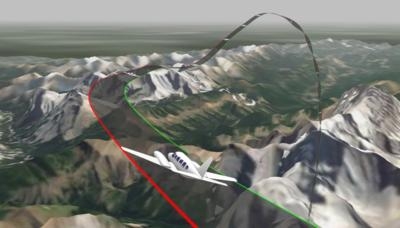Sat, Aug 03, 2019
Piper PA-31 Collided With Terrain In Kananaskis Country, Alberta
In the release of its investigation report (A18W0116), the Transportation Safety Board of Canada (TSB) found that hypoxia ... in-flight oxygen deprivation ... likely played a role in the loss of control that resulted in a fatal 2018 aircraft accident over Mount Rae, Alberta.

In the afternoon of 1 August 2018, after completing two hours of survey activities, an Aries Aviation International Piper PA-31 aircraft was proceeding to Calgary/Springbank Airport Alberta (CYBW), at 15,000 feet above sea level (ASL), with a pilot and a survey technician on board. Approximately 40 nautical miles southwest of the airport, air traffic control began sequencing the aircraft for arrival into the Calgary airspace. At this time, for reasons that could not be determined, the right engine began operating at a significantly lower power setting than the left engine. About 90 seconds later, at approximately 13,500 feet, the aircraft departed controlled flight. The aircraft collided with terrain near the summit of Mount Rae at 13:36 (MDT). The pilot and survey technician were both fatally injured.
The investigation determined that, although a portable oxygen system was activated and available, the pilot was not continuously using oxygen while the aircraft was above 13,000 feet ASL, as required by regulation, and likely became hypoxic. Although hypoxia can cause pronounced performance degradations, its onset can be slow and gradual, making it likely the pilot did not recognize the symptoms, and thus took no action to restore his supply of oxygen. The investigation also found that if flight crews do not undergo practical hypoxia training, there is a risk they will not recognize its onset when flying above 13 000 feet without continuous use of supplemental oxygen.
The aircraft was not equipped with a flight data recorder or cockpit voice recorder, nor were these required by regulation. However, the aircraft was equipped with a flight data monitoring system that included a camera. This system provided significant information to help TSB investigators better understand the underlying factors that contributed to the accident.
(Source: TSB news release. Image from TSB Report)
More News
Pilot Applied Full Aft Stick And Nose-Up Trim, But The Airplane Remained On The Runway Analysis: The pilot reported that a preflight inspection and flight control checks revealed n>[...]
A Few Questions AND Answers To Help You Get MORE Out of ANN! 1) I forgot my password. How do I find it? 1) Easy... click here and give us your e-mail address--we'll send it to you >[...]
From 2022 (YouTube Edition): Before They’re All Gone... Humankind has been messing about in airplanes for almost 120-years. In that time, thousands of aircraft representing i>[...]
Advanced Air Mobility (AAM) A transportation system that transports people and property by air between two points in the NAS using aircraft with advanced technologies, including el>[...]
Aero Linx: MQ-1B Predator The MQ-1B Predator is an armed, multi-mission, medium-altitude, long-endurance remotely piloted aircraft that is employed primarily as an intelligence-col>[...]
 NTSB Final Report: Douglas A-4K
NTSB Final Report: Douglas A-4K ANN FAQ: Q&A 101
ANN FAQ: Q&A 101 Classic Aero-TV: PBY Catalina--From Wartime to Double Sunrise to the Long Sunset
Classic Aero-TV: PBY Catalina--From Wartime to Double Sunrise to the Long Sunset ANN's Daily Aero-Term (07.01.25): Advanced Air Mobility (AAM)
ANN's Daily Aero-Term (07.01.25): Advanced Air Mobility (AAM) ANN's Daily Aero-Linx (07.01.25)
ANN's Daily Aero-Linx (07.01.25)



